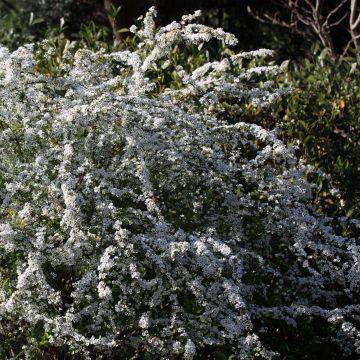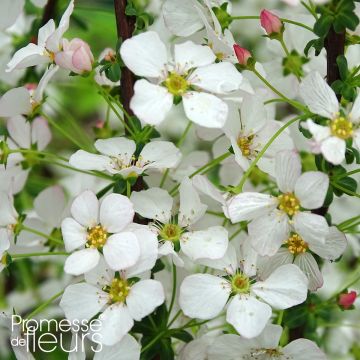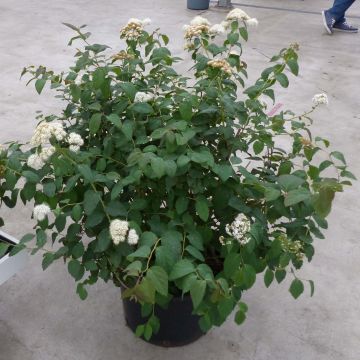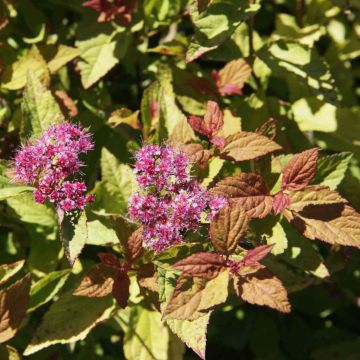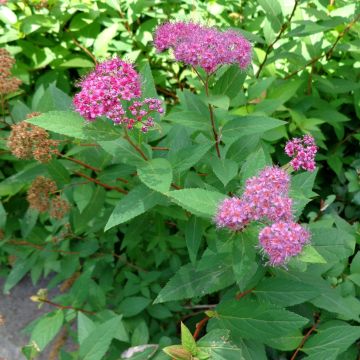

Spirée japonaise Nana - Spiraea japonica


Spirée japonaise Nana - Spiraea japonica
Spiraea japonica Nana
Spiraea japonica Nana
Japanese Spiraea, Japanese Meadowsweet
Lovely young plant arrived in good condition. The pruning delivered matches the presentation photo on the right-hand side of the screen. It looks healthy...
Linda, 18/04/2019
Special offer!
Receive a €20 voucher for any order over €90 (excluding delivery costs, credit notes, and plastic-free options)!
1- Add your favorite plants to your cart.
2- Once you have reached €90, confirm your order (you can even choose the delivery date!).
3- As soon as your order is shipped, you will receive an email containing your voucher code, valid for 3 months (90 days).
Your voucher is unique and can only be used once, for any order with a minimum value of €20, excluding delivery costs.
Can be combined with other current offers, non-divisible and non-refundable.
Why not try an alternative variety in stock?
View all →This plant carries a 24 months recovery warranty
More information
We guarantee the quality of our plants for a full growing cycle, and will replace at our expense any plant that fails to recover under normal climatic and planting conditions.


Would this plant suit my garden?
Set up your Plantfit profile →
Description
Spiraea japonica 'Nana' is a lovely dwarf form of Japanese Spirea. This small bush has a naturally low, spreading and dense habit and long summer flowering in carmine pink corymbs, often blooming again in autumn. Its beautiful deciduous foliage, tinted bronze in spring and dark green in summer, also takes on interesting autumnal colours. An ideal plant for small gardens, it works wonders in a small flowerbed, in a pot on the terrace, or in a larger border like boxwoods or lavenders. It is a hardy plant, adaptable to almost any soil, for growing in full sun or partial shade.
The 'Nana' Japanese Spiraea belongs to the Rosaceae family. It is a nearly prostrate form of the Japanese Spiraea, native to China and Japan. Its ornamental qualities and ease of cultivation have earned it recognition in England by the Royal Horticultural Society. The growth of this bush is slow, and its mature size will not exceed 50 cm (20in) in height and 1 m (3ft) in spread. Forming a low, spreading bush on the ground, this variety has bronze-purple foliage when opening, then dark green in summer, turning yellow and coppery-orange in autumn. It consists of small oblong and dentate leaves. The abundant flowers appear in June-July, and often again in September. They are grouped in medium-sized terminal corymbs of 10 cm (4in), in intense pink to violet-pink, at the tips of the current year's stems. This flowering attracts numerous pollinating insects.
With its compact and very low habit, this very hardy bush is ideal for adding structure to a perennial flower bed or in the composition of large borders. Combine the dwarf Japanese Spiraea with Caryopteris, white, pink, or mauve ground cover roses, creeping cotoneasters, dwarf forsythias, or lavenders and bush germander. This bush will be perfect as a large ground cover, in front of shrub beds or alongside pathways. You can place it in the front row of a rustic hedge, accompanied by other small-sized spireas (Spiraea betulifolia), dwarf red osier (Salix purpurea nana), the dwarf Manchurian lilac 'Miss Kim', or even dwarf weigela (Nana purpurea). It will grow very well in pots or planters with perennial geraniums on your terrace or balcony, in not too dry conditions.
Spiraea japonica Nana in pictures






Plant habit
Flowering
Foliage
Botanical data
Spiraea
japonica
Nana
Rosaceae
Japanese Spiraea, Japanese Meadowsweet
Cultivar or hybrid
Other Spiraea
View all →Planting and care
Plant the Japanese Spirea in any fairly rich soil, preferably moist and well-drained, in full sun, although it can tolerate partial shade. Water well in the first year. Prune in February-March to 10 - 15 cm (4 - 6in) from the ground: winter pruning is essential for beautiful flowering. Japanese Spiraea are repeat flowering plants: to encourage a second flush it is important to lightly prune the plant or remove faded flowers, to promote a resurgence in late summer/early autumn. This plant blooms on the current year's growth. To maintain the vigour of the plant it is also important to remove old branches at the base in spring. Apply a complete fertiliser in March. Preferably plant out in autumn and winter, leaving a spacing of 60 cm (24in) between the young plants.
Planting period
Intended location
Care
Planting & care advice
-
, onOrder confirmed
Reply from on Promesse de fleurs
Similar products
Haven't found what you were looking for?
Hardiness is the lowest winter temperature a plant can endure without suffering serious damage or even dying. However, hardiness is affected by location (a sheltered area, such as a patio), protection (winter cover) and soil type (hardiness is improved by well-drained soil).

Photo Sharing Terms & Conditions
In order to encourage gardeners to interact and share their experiences, Promesse de fleurs offers various media enabling content to be uploaded onto its Site - in particular via the ‘Photo sharing’ module.
The User agrees to refrain from:
- Posting any content that is illegal, prejudicial, insulting, racist, inciteful to hatred, revisionist, contrary to public decency, that infringes on privacy or on the privacy rights of third parties, in particular the publicity rights of persons and goods, intellectual property rights, or the right to privacy.
- Submitting content on behalf of a third party;
- Impersonate the identity of a third party and/or publish any personal information about a third party;
In general, the User undertakes to refrain from any unethical behaviour.
All Content (in particular text, comments, files, images, photos, videos, creative works, etc.), which may be subject to property or intellectual property rights, image or other private rights, shall remain the property of the User, subject to the limited rights granted by the terms of the licence granted by Promesse de fleurs as stated below. Users are at liberty to publish or not to publish such Content on the Site, notably via the ‘Photo Sharing’ facility, and accept that this Content shall be made public and freely accessible, notably on the Internet.
Users further acknowledge, undertake to have ,and guarantee that they hold all necessary rights and permissions to publish such material on the Site, in particular with regard to the legislation in force pertaining to any privacy, property, intellectual property, image, or contractual rights, or rights of any other nature. By publishing such Content on the Site, Users acknowledge accepting full liability as publishers of the Content within the meaning of the law, and grant Promesse de fleurs, free of charge, an inclusive, worldwide licence for the said Content for the entire duration of its publication, including all reproduction, representation, up/downloading, displaying, performing, transmission, and storage rights.
Users also grant permission for their name to be linked to the Content and accept that this link may not always be made available.
By engaging in posting material, Users consent to their Content becoming automatically accessible on the Internet, in particular on other sites and/or blogs and/or web pages of the Promesse de fleurs site, including in particular social pages and the Promesse de fleurs catalogue.
Users may secure the removal of entrusted content free of charge by issuing a simple request via our contact form.
The flowering period indicated on our website applies to countries and regions located in USDA zone 8 (France, the United Kingdom, Ireland, the Netherlands, etc.)
It will vary according to where you live:
- In zones 9 to 10 (Italy, Spain, Greece, etc.), flowering will occur about 2 to 4 weeks earlier.
- In zones 6 to 7 (Germany, Poland, Slovenia, and lower mountainous regions), flowering will be delayed by 2 to 3 weeks.
- In zone 5 (Central Europe, Scandinavia), blooming will be delayed by 3 to 5 weeks.
In temperate climates, pruning of spring-flowering shrubs (forsythia, spireas, etc.) should be done just after flowering.
Pruning of summer-flowering shrubs (Indian Lilac, Perovskia, etc.) can be done in winter or spring.
In cold regions as well as with frost-sensitive plants, avoid pruning too early when severe frosts may still occur.
The planting period indicated on our website applies to countries and regions located in USDA zone 8 (France, United Kingdom, Ireland, Netherlands).
It will vary according to where you live:
- In Mediterranean zones (Marseille, Madrid, Milan, etc.), autumn and winter are the best planting periods.
- In continental zones (Strasbourg, Munich, Vienna, etc.), delay planting by 2 to 3 weeks in spring and bring it forward by 2 to 4 weeks in autumn.
- In mountainous regions (the Alps, Pyrenees, Carpathians, etc.), it is best to plant in late spring (May-June) or late summer (August-September).
The harvesting period indicated on our website applies to countries and regions in USDA zone 8 (France, England, Ireland, the Netherlands).
In colder areas (Scandinavia, Poland, Austria...) fruit and vegetable harvests are likely to be delayed by 3-4 weeks.
In warmer areas (Italy, Spain, Greece, etc.), harvesting will probably take place earlier, depending on weather conditions.
The sowing periods indicated on our website apply to countries and regions within USDA Zone 8 (France, UK, Ireland, Netherlands).
In colder areas (Scandinavia, Poland, Austria...), delay any outdoor sowing by 3-4 weeks, or sow under glass.
In warmer climes (Italy, Spain, Greece, etc.), bring outdoor sowing forward by a few weeks.






























